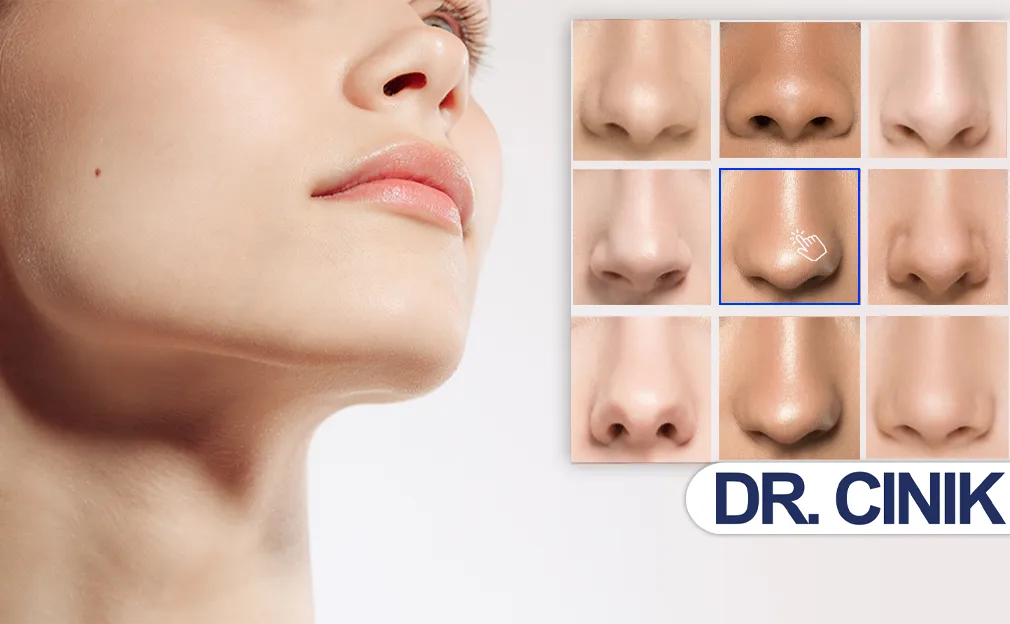Have you ever wondered “Would a different nose suit my face better?” Probably, millions of people looked in the mirror and asked themselves the same question.
Noses come in all shapes and sizes, and they play a huge role in defining our facial aesthetics. From an elegant Roman nose to cute button nose shape, each type has its own charm.
In this article, we’ll explore the different types of noses, their cultural and aesthetic significance, and how rhinoplasty can enhance or refine your look. Whether you’re curious about ethnic nose types or considering cosmetic surgery, we’ve got you covered.
Why Do Nose Shapes Vary?
Nose shapes are determined by particular combinations of genes, which in their turn are a result of long evolution, where natural selection served as a tool. In other words, it is evolution that shaped our noses. Lots of factors, such as climate, played their role. For example, flat nose shapes are more common in warmer climates (where wider nostrils help with heat regulation), while aquiline nose shapes (with a prominent bridge) are often seen in colder regions, where a longer nose helps warm inhaled air.
When it comes to nose types and beauty standards, remember that people’s ideas about beauty have shifted many times throughout history: what was considered aristocratic in one time period, might be seen as quite dull in another. Today, rhinoplasty (nose surgery) allows people to reshape their noses to match their ideal look… But fashion is fickle, don’t forget about it.
Common Nose Shape Types and Meanings People Assign to Them
Let’s break down the most common nose shapes and their characteristics. Some people believe that there is kind of a link nose shape-personality: in other words, your nose can tell something about traits of your character. While this is folklore rather than science, these opinions (or better say, stereotypes) are surprisingly tenacious!
1. The Roman Nose (Aquiline Nose Shape)
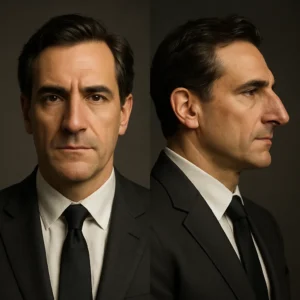
- Appearance: A prominent bridge with a slight downward curve.
This bold nose features a prominent bridge that curves outward like a gentle mountain slope. Anatomically, the nasal bones are strong, with a convex dorsum that starts its dramatic sweep right where the nose meets the forehead. While it gives profiles a regal edge (perfect for coin portraits), some feel it’s too dominant.
- Meaning: Often associated with strength and leadership.
- Famous Example: Actress Natalie Portman.
2. The Greek Nose (Straight Nose)
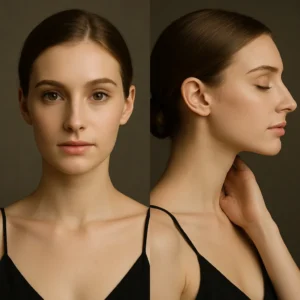
- Appearance: A perfectly straight bridge with narrow nostrils.
Straight as a ruler and just as precise, this nose is what happens when geometry and genetics high-five. Its near-perfect bridge (no humps, no bumps) creates such flawless symmetry that Renaissance artists used it as their “Ctrl+C, Ctrl+V” reference. Underneath, the septal cartilage is usually textbook-perfect, which is why surgeons love it.
- Meaning: Symbolizes classical beauty and symmetry.
- Famous Example: Actress Jennifer Aniston.
3. The Button Nose Shape
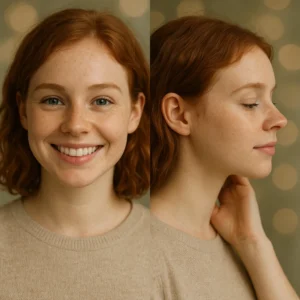
- Appearance: Small, upturned, and rounded at the tip.
Small, pert, and irresistibly squishable, the button nose is basically the puppy of nasal shapes. Its upturned tip (usually at a perky 105-110° angle) and rounded contours make it the go-to for “cute” character designs, though real-life owners sometimes are tired of being called “adorable” well into their 30s. Underneath that soft exterior lies surprisingly delicate cartilage that surgeons handle like blown glass.
- Meaning: Often seen as youthful and cute.
- Famous Example: Actress Emma Watson.
This is one of the most requested types of nose shapes female patients desire in rhinoplasty.
4. The Snub Nose

- Appearance: Short, slightly upturned, with a soft tip.
Short, slightly upturned, and forever stuck looking surprised, this nose is the facial equivalent of a surprised emoji. Anatomically, it’s like the button nose’s younger sibling who stopped growing early: nasal bones are petite, and the tip cartilage is often extra-flexible (great for comedy roles, less for poker faces).
- Meaning: Playful and approachable.
- Famous Example: Actress Elizabeth Taylor.
5. The Hawk Nose Shape
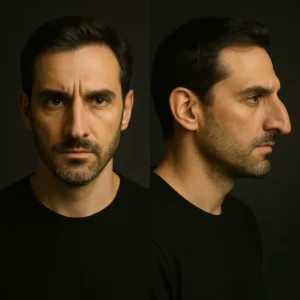
- Appearance: Sharp, downward-curving bridge.
With its sharp, downward-curving bridge, this nose means business. Anatomically, it’s like the Roman nose’s more intense cousin, with extra-dense cartilage at the tip. Perfect for dramatic stage roles… but if you’ve ever been asked “Why so serious?” at parties, you might consider tipping it up a few degrees.
- Meaning: Often linked to a bold, dramatic personality.
- Famous Example: Singer and actress Barbara Streisand.
6. The Flat Nose Shape
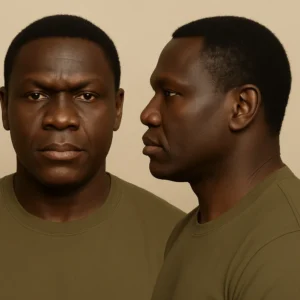
- Appearance: Low nasal bridge, wider nostrils.
This nose is evolution’s genius solution for tropical climates, where maximum airflow trumps ski-slope elegance. The nasal bones are shorter, giving the face a grounded, harmonious look. While some cultures historically saw this as “strong” and “authentic,” modern beauty ads still play hard to get with narrow bridges, though that’s slowly changing.
- Meaning: Common in many ethnic nose types, especially African and Asian ancestries.
- Famous Example: Actor Idris Elba.
7. The Bulbous Nose
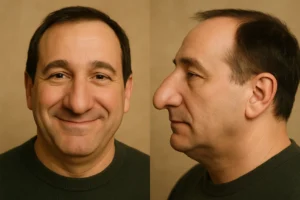
- Appearance: Rounded, wide nasal tip with thick skin.
- Meaning: Often seen as friendly and warm.
Round, cheerful, and impossible to ignore, this nose tip is like the mic drop of facial features. Under its thick skin (literally), cartilage spreads out like a pancake—giving surgeons a challenge to sculpt definition without losing its infectious charm. Pro: Great for Santa roles. Con: Resting “jolly” face.
- Famous Example: Comedian Jimmy Durante.
8. The Nubian Nose
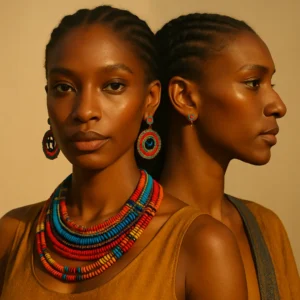
- Appearance: Long bridge with wide, flared nostrils.
This nose is a masterclass in airflow efficiency and cultural uniqueness. The nasal bones are strong but elegantly tapered, while the alar base (that’s fancy talk for nostril zone) gives the face regal proportions.
- Meaning: Common in African and Afro-Caribbean ethnicities.
- Famous Example: Supermodel Naomi Campbell.
9. The Nixon Nose (Straight with a Rounded Tip)

(Richard Nixon’s official portrait, 1972) Source
- Appearance: Straight bridge with a slightly bulbous tip.
Straight but with a twist — literally. The tip cartilage takes an unexpected turn toward bulbousness, like a politician dodging a question. Anatomically, it’s a study in contrasts: disciplined bridge, rebellious tip. Surgeons often approach it like diplomats—negotiating balance without compromising character.
- Meaning: Named after the former U.S. president.
- Famous Example: Former President Richard Nixon.
10. The Celestial Nose (Turned-Up)
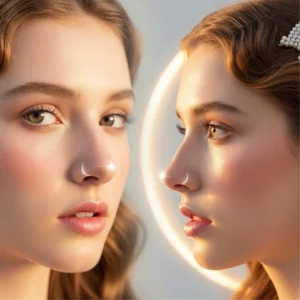
- Appearance: Delicate, slightly upturned tip.
Delicately upturned, this nose is the reason words like “ethereal” “and angelic” were invented. The tip tilts up just enough to avoid “piggy” territory (around 100°), supported by fine cartilage that surgeons treat like origami paper.
- Meaning: Considered very feminine and elegant.
- Famous Example: Actress Carey Mulligan.
It’s among the types of nose shapes male patients feel like correcting, while women usually don’t.
Ethnic Nose Types and Cultural Perceptions
Nose shapes vary significantly across different ethnic groups. While no single feature defines an entire ethnicity, certain nasal characteristics are more common in specific populations. Let’s briefly explore how ethnic nose types differ and how cultural perceptions shape aesthetic preferences.
1. African and Afro-Caribbean Nose Types
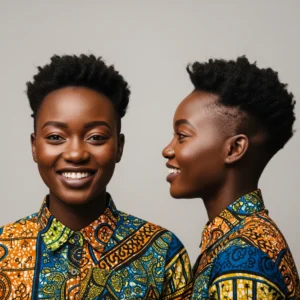
- Common Features: Wider nostrils, a flat nose shape, and a lower nasal bridge.
- Why? Evolutionary adaptation to humid climates: broader nostrils allow for better airflow.
- Cultural Significance:
Historically, broader noses were celebrated in African art and sculpture, symbolizing strength and heritage.
Modern beauty standards in Western media have often favored narrower noses, leading some to seek rhinoplasty for narrowing nostrils or raising the bridge.
However, movements like “Black is Beautiful” have pushed back, encouraging people appreciate their natural features.
2. Asian Nose Types

- Common Features: A shorter nose, flatter bridge, and softer nasal tip.
- Why? Genetic traits common in East and Southeast Asian populations.
- Cultural Significance:
In many Asian cultures, a high, narrow nose has been traditionally seen as desirable, influenced by Western beauty standards in media.
“Double eyelid and high nose“ is a common aesthetic goal in countries like South Korea and Japan.
Non-surgical rhinoplasty (filler-based nose jobs) is popular in Asia for temporarily enhancing the bridge without surgery.
3. Caucasian Nose Types (European & Middle Eastern)

- Common Features:
- Northern Europeans: Straight or slightly upturned (Greek nose), narrow nostrils.
- Southern Europeans & Middle Eastern: Stronger bridges, sometimes with a dorsal hump (Roman nose, or aquiline nose shape).
- Cultural Significance:
The Greek nose has long been idolized in classical art as the “perfect” nose. In some cultures, a strong nose is associated with nobility (e.g., the “royal” aquiline nose). So, there is no winner in the Roman nose vs Greek nose dispute.
4. Hispanic and Indigenous Nose Types
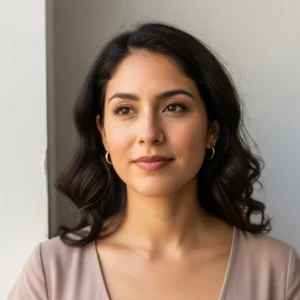
- Common Features:
Vary widely, but often include a medium-width bridge, slightly rounded tip, or subtle hump.
Some Indigenous groups have broader, flatter noses, similar to Asian or African types.
- Cultural Significance:
Colonial beauty standards have sometimes favored European features, leading to rhinoplasty requests for narrowing or lifting. However, many people now embrace their natural traits, rejecting Eurocentric ideals.
5. South Asian (Indian, Pakistani, Bangladeshi) Nose Types

- Common Features:
- Thicker skin, a rounded or slightly drooping tip, and a medium-width bridge.
- Some have a dorsal hump, similar to Middle Eastern noses.
- Cultural Significance:
Bollywood beauty standards have long favored delicate, refined noses.
Rhinoplasty in South Asia often focuses on tip refinement and hump reduction, while keeping a natural look.
How Beauty Standards Influence Rhinoplasty Choices
- Westernization vs. Ethnic Preservation: Some patients choose a nose that aligns with Eurocentric ideals. Others seek only subtle tweaks that preserve their ethnic identity.
- Celebrity Influence: Stars like Priyanka Chopra (who refined her nasal tip) or Michael Jackson (who underwent multiple nose surgeries) have impacted trends.
- Modern Shift: More surgeons now specialize in ethnic rhinoplasty, ensuring changes complement the patient’s natural facial structure rather than erasing cultural traits.
Key Takeaway
While both nose types and beauty standards vary greatly, the best aesthetic results imply individuality. Whether you embrace your natural shape or opt for subtle refinements, the goal should always be confidence, not toeing the line.
Read more: Blake Lively’s Nose Job: Natural Glow or Hollywood Surgery?
Rhinoplasty by Nose Type: Surgical Solutions
One of the reasons you should know types of noses — rhinoplasty, if you’re considering it. The procedure varies based on your natural shape. Here’s how surgeons approach different cases:
Correcting a Bulbous Tip
- Technique: Refining the cartilage to create a more defined tip.
- Best for: Those wanting a sharper, less rounded nose.
Reducing a Dorsal Hump (Roman or Aquiline Nose Shape)
- Technique: Shaving down the hump for a smoother profile.
- Best for: Patients desiring a straighter bridge.
Lifting a Droopy Tip
- Technique: Adjusting cartilage to elevate the tip.
- Best for: Hawk noses or aging noses that sag.
Narrowing Wide Nostrils (Flat Nose Shape)
- Technique: Alar base reduction to refine nostril width.
- Best for: Patients seeking a more balanced look.
Augmenting a Flat Bridge
- Technique: Using implants or cartilage grafts to add height.
- Best for: Asian or African patients wanting more projection.
Choosing Rhinoplasty Based on Nose Shape
Wondering about the best nose shape for face harmony? Here what surgeon considers when making a decision:
- Facial proportions (the golden ratio).
- Gender differences (softer tips for women, stronger bridges for men).
- Ethnic preservation (avoiding a “one-size-fits-all” approach).
A really good surgeon won’t give everyone the same nose; they’ll enhance what suits you.
Nose Shape Guide for Rhinoplasty Patients: How to Choose the Right Procedure
If you’re considering rhinoplasty, the first step is answering questions: what is my nose shape and how it will influence surgical options? Not all noses are reshaped the same way: what works for a button nose shape, won’t necessarily suit an aquiline.
Pro Tip: Bring reference photos, but let your surgeon recommend what suits your anatomy. After all, even the most beautiful Greek nose won’t fit every face!
Read more: Important Things to Consider Before Getting a Nose Job in Turkey
Common Rhinoplasty Solutions for common nose shapes
Here are the most frequent reasons why people opt for a rhinoplasty:
1. The Bulbous Nose
Common Concerns: Lack of definition, overly rounded, “boxy” tip.
Rhinoplasty Solutions:
- Tip Refinement:
Bulbous noses usually have extra-wide lower lateral cartilages. By reshaping and repositioning them, surgeons create natural-looking angles instead of a “boxy” silhouette. Surgeons carefully sculpt the thick cartilage at your nasal tip (imagine a barber thinning out bulky hair layers) to create a more tapered shape. This often involves:
- suturing (stitching) the tip cartilages closer together (like lacing a corset for your nose).
- thinning soft tissue, i.e.., removing excess fibrous tissue under the skin (but not too much, or you’ll see every cartilage bump!).
2. The Roman or Aquiline Nose (Dorsal Hump)
Common Concerns: Prominent dorsal hump, overly strong bridge; desire for a straighter profile.
Rhinoplasty Solutions:
- Hump reduction
The surgeon doesn’t just “shave off” the bump: they rebuild your nose like a sculptor:
- Filing bone/cartilage: Using rasps (like nail files for bone) to smooth the hump.
- Bridge realignment: Sometimes, the surgeon has to break nasal bones and reset them into a better position to achieve a straighter line.
- Tip adjustment: Often combined with lifting a droopy tip to balance proportions.
3. The Flat or Wide Nose
- Common Concerns: Lack of projection, too wide nostrils.
Rhinoplasty Solutions:
- Bridge Augmentation:
Think of this as “nose contouring” with permanent makeup.
Surgeons can elevate flat nose bridge using implants or grafts, i.e., silicone implants (pre-shaped) or the patient’s own rib/cartilage (more natural, but recovery will take longer).
African and Asian patients often prefer 2-4mm of added height, which is enough for definition without erasing cultural traits.
- Alar base reduction: If nostrils are too wide, tiny incisions at the base will narrow them subtly.
- Tip elevation will create more definition.
4. The Button or Snub Nose
- Common Concerns: Overly upturned tip, lack of length (“I look like a startled anime character!”)
Rhinoplasty Solutions:
- Lengthening the Nose:
- Septal extension grafts: Cartilage from your septum (or ear) extends the columella (the external part at the bottom of the septum).
- Tip positioning: Slightly lowering the over-rotated tip for more balanced look.
- Adding structure to reinforce support and prevent the “piggy nose” effect (when an over-rotated tip exposes nostrils too much).
5. The Hawk, or Droopy, Nose
Common Concerns: “Witchy” appearance, obstructed nostrils.
Rhinoplasty Solutions:
- Tip Rotation:
The drooping tip is lifted using sutures or cartilage grafts.
- Dorsal Hump Reduction:
The prominent bump is smoothed, but good surgeons will advise you to preserve some height — e.g., keeping a subtle dorsal hump on Middle Eastern noses for cultural identity. Skilled surgeons enhance, not erase your heritage.
- Septum adjustment, if necessary: patients with hawk noses may experience difficulty in nasal breathing due to deviated septum.
6. The Greek, or Straight, Nose
Common Concerns: Minor asymmetries, subtle refinements (the tip looks too wide, there’s a tiny bump showing up in every selfie)
Rhinoplasty Solutions:
- Micro-Tip Refinement
Transdomal Sutures: Surgeons place internal stitches to gently narrow the tip cartilages (like cinching the drawstring on a hoodie).
Cartilage Trimming: The surgeon removes no more than 1-2mm of excess from the lower laterals. Thick-skinned patients may need soft tissue thinning to reveal the refined shape.
- Bridge Perfection
Cartilage Rasping: The surgeon smooths minor irregularities with a special tool.
Camouflage Grafts: For asymmetries, surgeon tucks rice-grain-sized cartilage pieces under the skin.
Why It’s Tricky:
Over-refining a Greek nose leads to the dreaded “operated” look. Experienced surgeons love the idea of imperfect perfection (think of a handmade Stradivarius violin).
How Surgeons Customize Rhinoplasty by Nose Type
As to aesthetic nose types and correction options, surgeons consider:
A. Skin Thickness
- Thin skin: Shows every detail, so requires ultra-precise sculpting.
- Thick skin: Needs stronger cartilage support to prevent drooping.
B. Ethnic Considerations
- African/Asian noses: Often need bridge augmentation without over-narrowing.
- Middle Eastern noses: May require hump reduction while keeping a strong profile.
- Caucasian noses: Frequently focus on refining the tip or straightening the bridge.
C. Gender Differences
- Female rhinoplasty: Softer, slightly upturned tips are common.
- Male rhinoplasty: Stronger bridges and straighter profiles are preferred.
Choosing the Right Rhinoplasty Technique: Open vs. Closed Rhinoplasty
Open Rhinoplasty: The “Full Blueprint” Approach
Best for:
- Major reshaping (bulbous tips, crooked noses, ethnic rhinoplasty)
- Revision surgeries (fixing previous nose jobs)
- Complex cases requiring cartilage grafts
What to Expect:
- A small incision across the columella, plus internal cuts.
- Surgeons lift the skin to expose the entire nasal structure, like opening a hood to access a car engine.
- Pros: Better visibility for precise changes.
- Cons: Slightly longer recovery (external scar fades to near-invisible in 6-12 months).
Closed Rhinoplasty: The “Stealth Mode” Option
Best for:
- Minor refinements (small hump reduction, slight tip tweaks)
- Patients who want no external scars
- Faster recovery (back to work in about a week)
What to Expect:
- All incisions are inside the nostrils, so there is no visible scarring.
- Surgeons work “blindly” (using tactile feedback and experience), like a mechanic fixing a watch through its back panel.
- Pros: Less swelling, quicker healing.
- Cons: Limited access for complex changes.
Non-Surgical Options
- Fillers (Liquid Rhinoplasty)
- What it does: Smooths bumps, lifts droopy tips, or adds bridge height.
- Materials: Hyaluronic acid (Juvederm, Restylane) lasts 12-18 months.
- Catch: Can’t reduce size or fix breathing issues. Risk of vascular complications if injected incorrectly.
- Best for: First-timers testing a new shape, or brides wanting a temporary fix.
- Thread Lifts
- What it does: Polydioxanone (PDO) threads lift the tip slightly for 6-12 months.
- Reality Check: Mild results (~15% lift). Threads dissolve, but scar tissue may provide subtle lasting change.
- Best for: Those afraid of surgery with very minor drooping.
Surgical vs. Non-Surgical
|
Concern |
Open/Closed Surgery |
Fillers/Threads |
|---|---|---|
|
Reduce a hump |
✅ Permanent |
❌ Can’t reduce |
|
Lift the tip |
✅ Lasts decades |
⏳ Temp (1-2 yrs) |
|
Fix breathing |
✅ Yes |
❌ No |
|
Downtime |
2-4 weeks |
2 days |
Read more: Rhinoplasty in Turkey: Nose Job Dreamland
Questions to Ask Your Surgeon Before A Rhinoplasty
Before booking surgery, discuss:
- “What is the best nose shape for my face?” (Balance is the key!)
- “Can you show me images of possible results?” (Visualize changes.)
- “Will my nose still look ethnic/natural?” (Avoid Over-Westernization.)
- “What’s the recovery time for my nose type?” (Thick skin takes longer to heal.)
The Final Advice
Now that you have this nose shape guide for rhinoplasty patients, you’re equipped to make smart choices. Rhinoplasty isn’t about chasing trends; it’s about enhancing harmony. Whether you want to reduce a dorsal hump, refine a bulbous tip, add height to a flat bridge, the best results come from working with your natural shape, not against it. Consult a board-certified surgeon to explore types of noses and surgical solutions tailored for you.
Your nose is as unique as you are; whether you keep it natural or opt for a tweak, the best look is the one that makes you happy.
